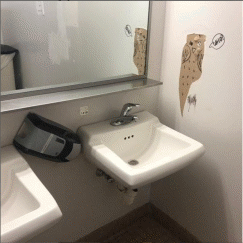Introduction
Socio-historical characteristics in educational institutions are an integral part of the maturation of any unit of society. Educational psychologists are interested in the role of school facilities since the daily interactions between school users and their buildings directly impact education and learning (Durán-Narucki, 2011). The visual aspect of the interiors and exteriors of schools leaves a solid psychological imprint on the person. This paper will consider an image that reflects the current state of the aforementioned infrastructures.
Analysis
First, it is required to analyze the attached image in detail (see Figure 1). It shows a damaged public restroom near the depicted owl. Next to it is written the phrase “Who,” suggesting that the bird is animate and in dialogue with the viewer. I was interested in this image because it has its roots in personal experience and my reflections. It has always been incomprehensible to me why students damage school property by rendering it unusable. Based on this and articles available on related topics, it is possible to assume that this misunderstanding is due to different behaviors and perceptions of socio-historical specificity (Evans, 2021). Furthermore, the image itself is unintentionally a symbol of the fact that, along with the pests, there are also those who, through art, try to appeal to the human conscience. Based on the available reasoning of independent researchers, school to a greater extent reflects a micro-society in which students try out different roles in life (Jofee-Walt, 2015). Thus, the image shown has symbolic and referential meanings to many social and psychological concepts.
Conclusion
In conclusion, the above analysis demonstrates the versatility and value of the image presented. Such reasoning allows us to draw the public’s attention to the many aspects inherent in various issues of public schools. From this, one may conclude that if the problems of damaged interiors and exteriors of educational institutions are made public from this perspective, the public interest may increase. Such tendency may lead to measures that will trigger a mass renovation of buildings and interior spaces.
References
cuny_brokelyn_college. (2020). Boylan Hall, 5th Floor Women’s Bathroom. [Photograph]. Instagram. Web.
Durán-Narucki, V. (2011). Built-in: Meaning and the reproduction of socio-historical characteristics in public schools buildings in the US. Educational & Child Psychology, 28(1), 114–119. Web.
Evans, G. W. (2021). The physical context of child development. Current Directions in Psychological Science, 30(1), 41–48. Web.
Joffe-Walt, C. (2015). Three Miles. This American Life. Web.
Appendix A

Note. The photograph was collected from cuny_brokelyn_college. (2020). Boylan hall, 5th floor women’s bathroom. Soup dispenser has been ripped out of the wall. Submit something that’s broken in [Instagram post]. Instagram. Web.
